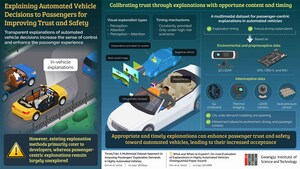GIST Researchers Improve Water Splitting Reaction for Green Hydrogen Gas Production
GWANGJU, South Korea, Nov. 16, 2023 /PRNewswire/ -- Green hydrogen (or H2) produced from renewable energy resources is the fuel of a decarbonized future. Electrolysis or splitting of water into oxygen and hydrogen with the help of an electrochemical cell is one of the most popular ways of producing green H2. It is a simple reaction, ensures high-quality products, and has zero carbon emissions. Despite its advantages, however, electrochemical water splitting is yet to gain prominence on a commercial scale. This is because of the low electrical conductivity of active (oxy)hydroxide catalysts generated in situ during the electrochemical processes. This, in turn, leads to restricted catalytic activity, hampering hydrogen as well as oxygen evolution reactions in the cell.
The problem of (oxy)hydroxide's poor electrical properties has been a long-standing challenge towards the achievement of efficient water splitting. Now, a team of researchers led by Associate Professor Junhyeok Seo from the Department of Chemistry at Gwangju Institute of Science and Technology, have found a solution to this issue in the form of Schottky junctions.
In a recent study made available online on 30 August 2023 and to be published in Volume 340 of the Applied Catalysis B: Environmental journal in January 2024, they demonstrated an electrode with Schottky junction formed at the interface of metallic nickel-tungsten nitride (Ni-W5N4) and semiconducting n-type nickel-iron (oxy)hydroxide (NiFeOOH) catalyst. This electrode was able to overcome the conductance limit of (oxy)hydroxide and improved the water splitting ability of the setup.
Notably, two materials, a metal and a semiconductor, with largely different electronic behaviors were put in contact to make an energy difference at the interface, forming a junction. "Our research utilized this potential energy barrier present in the Schottky junction to accelerate electron flow in the electrode, leading to a significant increase in oxygen evolution reaction activity, expediting overall water splitting," explains Dr. Seo, highlighting the core mechanism behind their newly designed electrode.
Upon carrying out electrocatalytic water splitting, the team observed that Ni-W5N4 alloy catalyzed the hydrogen evolution reaction, resulting in 10 mA/cm2 current density at a small overpotential of 11 mV. Furthermore, the rectifying Schottky junction formed at the interface of Ni-W5N4|NiFeOOH nullified the non-conductive lamination produced by (oxy)hydroxide species. In forward bias, it exhibited a current density of 11 mA/cm2 at 181 mV overpotential. The electrochemical analysis of the electrode revealed that the improved catalytic activity could indeed be attributed to the Schottky junction.
Lastly, the researchers designed an electrolyzer using their Schottky junction electrode for industrial seawater electrolysis. They found that the new device could operate continuously for 10 days, while also exhibiting outstanding catalytic activity and durability during electrolysis. It showed a remarkable current density of 100 mA/cm2 at an overpotential of just 230 mV.
Overall, the researchers believe that these findings can contribute toward a sustainable strategy for hydrogen production to eventually replace conventional methods that still rely on fossil fuels. As Dr. Seo concludes, "Freshwater and seawater are abundant and renewable sources of protons. Efficient water splitting systems ensure that we can establish sustainable production of zero carbon hydrogen fuel, thus helping manage our current climate problems."
Let us hope that the successful demonstration of Ni-W5N4|NiFeOOH electrode for water splitting opens up new avenues for Schottky junction-based durable and high-performance energy storage and conversion systems!
Reference
Title of original paper: Schottky switch derived by metallic W5N4 | catalyst junction: Switch-on to enhance catalytic activity and durability in water splitting reaction
Journal: Applied Catalysis B: Environmental
DOI: https://doi.org/10.1016/j.apcatb.2023.123233
About the Institute
Media Contact:
Chang-Sung Kang
82 62 715 6253
[email protected]
SOURCE Gwangju Institute of Science and Technology (GIST)

WANT YOUR COMPANY'S NEWS FEATURED ON PRNEWSWIRE.COM?
Newsrooms &
Influencers
Digital Media
Outlets
Journalists
Opted In






Share this article